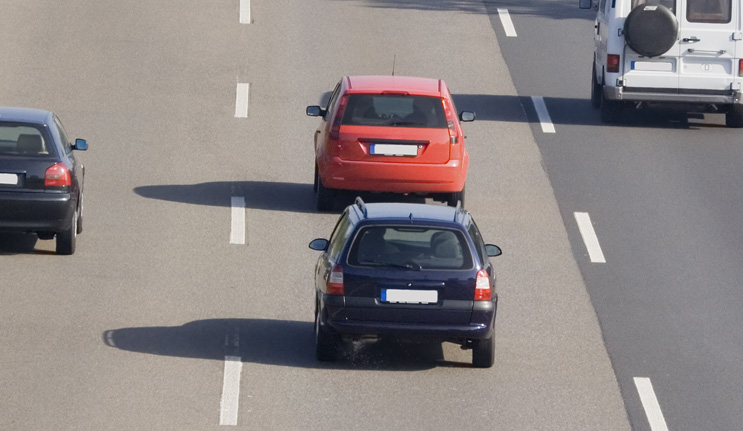After a while, we often believe things which may not be true. As a kid, if you began telling a lie to cover your tracks, you may actually believe it over time. Driving knowledge which leads into skills can also fall into this category of false facts. Things we were told which were incorrect we may believe over time. It’s now time to correct this misinformation to help keep you safe on the roads.
Many drivers harbor the belief that following distance is measured by car lengths. Sorry to deliver the bad news, but that’s not the case. If you think about it, the faster you drive the longer it takes to stop your vehicle when you apply your brakes. Also, the slower you drive the less time it takes to stop your vehicle. If you use car lengths as a measurement tool, you’re decreasing your chances of stopping quickly enough when the need arises. It also means you may not be looking far enough ahead to read the traffic pattern. The main reason for this is you’re too busy checking to see if you have two car lengths of space between your vehicle and the vehicle ahead of you. Using car lengths to measure following distance often means you’re tailgating.
Tailgating is never the answer. Did you know tailgating a larger vehicle can significantly obstruct your view of the road ahead? If you maintain the proper following distance from the vehicle in front of you, you can see traffic slowdowns in advance or even switch lanes to help you reach your destination sooner. Have you thought about how much damage you could cause to your own vehicle if you rear-end another vehicle? Modern vehicles have so many electronic sensors that what may appear to be a couple thousand dollars of cosmetic damage could actually be almost $10,000? Why would you want to purposely do that to your own possession?
In order to safely stop your vehicle when the driver ahead of you brakes hard, there are a few things that have to take place. The first step occurs when your brain receives a message from your eyes telling you the brake lights on the vehicle ahead of you have been activated. Your brain decides if the driver ahead is braking gradually or harshly. This doesn’t take a lot of time, but it does take time. From there your brain sends a message to your foot to come off the accelerator and reach for the brake pedal. At this time, you haven’t applied the brake yet. How would two car lengths give you enough time to do this, especially at higher speeds? It doesn’t. Drivers need time to stop quickly in traffic. They need time to see the brake lights, time to respond by moving their foot from the accelerator to the brake, and finally, time to stop their vehicle. So if we need that much time, why not measure the following distance in time?
If we’re driving within the city at 30 mph on dry roads, a minimum safe following distance would be two seconds. One thousand one, one thousand two. That’s it. That’s all it would take to avoid one of the most leading crashes in all of North America. When the bumper of the vehicle ahead of you passes a fixed object at the side of the road, begin counting. The front of your vehicle should not reach that point before you finish two seconds. I’ve heard drivers say if they left that amount of space between vehicles, other drivers would cut them off and take away that space. Not really. Drivers who want to cut you off will do that regardless of how much space you have. Leaving extra space can give you more time to stop if they cut in front of you and then brake. It’s still a winning solution.
I’ve asked licensed drivers to conduct an informal survey as they travel to work or home. I asked them to count how many drivers merge into the space in front of them versus how many drivers pass them and do not merge into that space. I’ve given them my email address to let me know. To this day, I have not received any emails stating more drivers have merged into that space compared to those who have continued to drive along. I’m not surprised.
The drivers who believe the story about getting cut off if they leave too much space in front of them goes back to what I said earlier. You may believe false facts as the years progress. So now that I’ve explained why you need a minimum of two seconds of following distance while driving at city speeds, you need to know when that distance should be increased.
Increasing your following distance is important when your stopping distance increases. Traveling faster is one of those times. Driving on the highway can actually triple your stopping distance. For this reason, leaving at least three seconds between your vehicle and the vehicle directly in front is a smart idea. Since you never know all the reasons why drivers might slam on their brakes, you do need to give yourself a fighting chance to safely stop. You owe that to yourself and your passengers. They’re counting on you to keep them safe.
Keep Your Fleet Drivers Safe on the Road with these eLearning courses:
Tailgating Awareness — Small Vehicles
Tailgating Awareness — Large Vehicles
When traveling at 30, 35 or 40 mph, you should also increase your following distance if the road conditions are not ideal. Rain, snow and ice greatly increase stopping distance. What makes you think you can stop in time when conditions are less than model perfect? Another example of when you need to increase your following distance is if you’re being tailgated. If you maintain the appropriate following distance and the driver ahead of you brakes hard, you will have time to come to a complete stop in a safe manner. However, the tailgater behind you would not. So at city speeds, if you’re being tailgated, increase your following distance to another second or two. This way, when the driver ahead brakes hard, you won’t have to brake as hard. This means the driver behind you would not have to brake as hard either, helping you avoid being rear-ended.
Patience plays an integral role when you’re traveling the roads. You’ll still reach your destination if you keep the correct number of seconds between your vehicle and the vehicle ahead of you. In the city, tailgating often means you’re tailgating toward a red light. So why do it? Tailgating won’t get you there any sooner. Be a smart driver. One who’s always thinking ahead. That will get you and your passengers to your destination safely. Isn’t that what it’s all about anyway?
About the Author

Scott Marshall has spent over 30 years promoting road safety. He has been a road safety journalist since 2005. Scott was also an on-air judge on the Discovery Network’s Canada’s Worst Driver during its first three seasons. Scott welcomes any questions or comments you may have at safedriver36@yahoo.ca.
Stay safe on the road with these training courses on driving safety:



